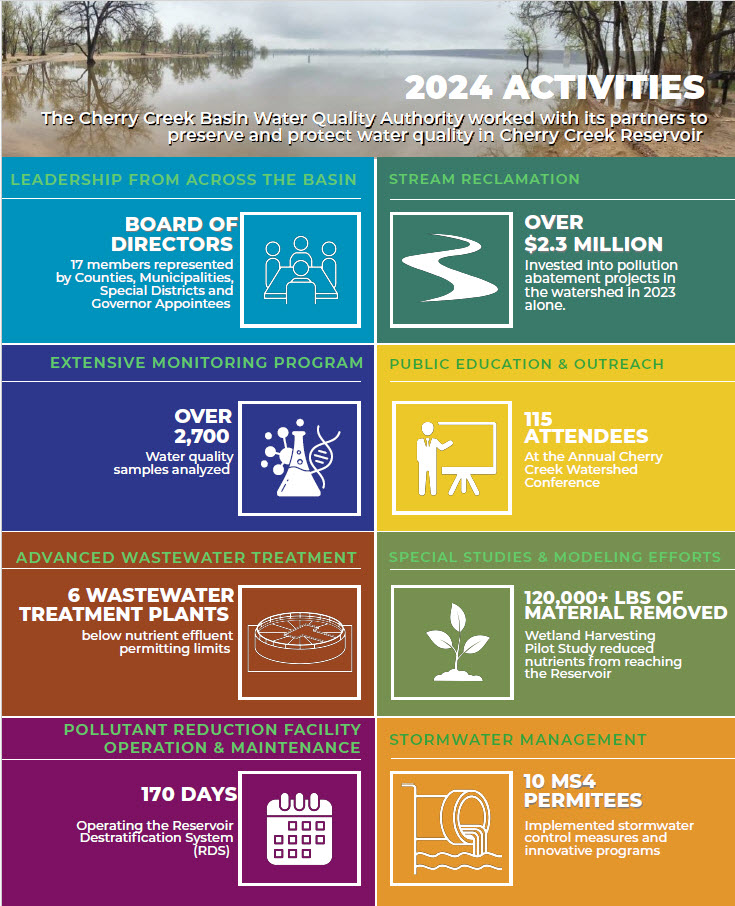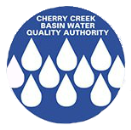2024 Annual Report on Activities
Cherry Creek Basin Water Quality Authority
- How is the Reservoir?
- How is the watershed?
- What did we do to preserve water quality?
- What we learned from studies and special projects conducted in 2024
- What are our plans for 2025?
Some links in the Annual Report contain public documents. The CCBWQA is committed to providing accessible content to the public as outlined in our Website Accessibility Statement. Historic internal CCBWQA content posted to the website prior to July 1, 2024 has been archived and all current documents have been remediated to applicable WCAG 2.1, Level A standards or above. If need help accessing internal CCBWQA content, call us at 303.968.9098 or email us at manager@ccbwqa.org.
Key Takeaways from Water Year 2024 (10/1/2023– 9/30/2024)

During 2024, the Cherry Creek Basin Water Quality Authority worked with its partners to preserve and protect water quality in Cherry Creek Reservoir (Reservoir). This work includes an extensive reservoir and watershed monitoring program, stream reclamation projects, operation and maintenance of Pollutant Reduction Facilities, operation of the Reservoir Destratification System, special studies and modeling efforts, public education and outreach, and other efforts. Local governments and entities operating wastewater reclamation facilities use advanced treatment technology to maintain total phosphorus in treated effluent at 30-day average concentrations below 0.05 mg/L. Municipal stormwater managers implemented stormwater management programs in accordance with Regulation 72 requirements to minimize the adverse effects of stormwater runoff on streams and the Reservoir.
Highlights of our 2024 activities are briefly summarized below.
How is the Reservoir?
Cherry Creek State Park has a record number of visitors every year, and the Reservoir continues to provide space where people enjoy recreating and connecting. Colorado Parks and Wildlife biologists reported that the walleye fishery is doing well.
Due in part to on-going efforts to reduce nutrient loading to the Reservoir, the Reservoir attained its chlorophyll-a standard of 18 ug/L during 2024. The average chlorophyll-a concentration was 16.4 ug/L for the growing season of July through September. The Reservoir has exceeded the standard for four of the past five years; however, the average chlorophyll-a concentrations were the lowest they’ve been in the last five years. Additionally, an undesirable blue-green algae bloom in late July was responsible for closure to human contact due to the detection of toxins. The bloom and associated toxins were only detected for a few days. Seasonal phosphorus concentrations in the Reservoir were higher than the long term median, but significantly lower than last year.The Reservoir attained the Regulation 38 water quality standards for temperature, pH, and dissolved oxygen.
Some of the factors affecting conditions in the Reservoir are challenging or impossible to control and result in year-to-year variations in water quality and environmental conditions.
Some of these factors include weather conditions such as temperature, wind, and precipitation patterns. The Reservoir received close to average annual precipitation in 2024, with significantly lower rain than average from May through July. Other factors include natural sources of phosphorus loading from the watershed and alluvial groundwater and the release of stored nutrients from Reservoir sediments (internal loading). CCBWQA operates a Reservoir Destratification System from April through October to help mitigate some of these influences.
How is the watershed?
The 386 square mile watershed has experienced significant growth since Control Regulation 72 was implemented. Baseline loading of phosphorus from wastewater reclamation facilities is well controlled, with these point sources contributing less than three percent of the phosphorus load to the Reservoir.
CCBWQA monitors phosphorus and nitrogen concentrations in Cherry Creek and Cottonwood Creek since they are the two main inflows to the Reservoir.
Key findings from 2024 include:
- Median total phosphorus concentrations in baseflows and storm flows were lower than long term medians in Cherry Creek and Cottonwood Creek.
- Phosphorus concentrations in Cottonwood Creek are ~ 60% lower than concentrations in Cherry Creek.
- Total nitrogen concentrations in both Cherry Creek and Cottonwood Creek were slightly higher than the long term historical median.
- Median nitrogen concentrations in Cherry Creek were 50% lower than concentrations in Cottonwood Creek in base flows.
- The CCBWQA pollutant reduction facilities (PRFs) on Cottonwood Creek are effectively reducing phosphorus and suspended solids during storm flows.
- Median nutrient concentrations are lower downstream of the stream reclamation project on McMurdo Gulch
What did we do to preserve water quality?
CCBWQA and its partners continue to implement pollutant reduction facilities and stormwater control measures, construct stream reclamation projects and conduct other activities to reduce nutrient loading throughout the watershed. Key 2023 capital improvement projects in the watershed include:
- Dove Creek Phase 2 Chambers Road to Pond D-1: In 2024, Phase 2 of the Dove Creek stream restoration project was completed. The project included step pool structures for grade control, bank protection (void-filled riprap, soil lifts, and vegetation), and grading to create overbanks providing a wider stream corridor which stabilizes the stream and reduces erosion potential. The Southeast Metro Stormwater Authority (SEMSWA) was a project partner.
- Projects Under Construction in 2024 (both projects are expected to be completed in the Spring of 2025):
- Cherry Creek at Dransfelt
- Cherry Creek at Scott Avenue
- Wetlands Harvesting Project: In 2024, CCBWQA completed year four of a six-year pilot project to cut and dispose of wetland vegetation to reduce phosphorus and nitrogen from being carried to Cherry Creek Reservoir after the plants decay.
What we learned from studies and special projects conducted in 2024.
During 2024, CCBWQA conducted several special studies including:
Stormwater Best Management Practice (BMP) Effectiveness Study: CCBWQA continued a study to synthesize the most current information on the expected effectiveness of stormwater BMPs (also known as stormwater control measures). A draft report was submitted in 2024 and will be finalized in 2025.
Receiving Pervious Area Study: CCBWQA is partnering with SEMSWA and the Mile High Flood District to develop a more quantitative understanding of volume reduction benefits of receiving pervious areas such as grass buffers, grass swales and other landscape areas. Reducing runoff volumes through green infrastructure can reduce pollutant loads and channel erosion. The final report was completed in 2024.
What are our plans for 2025?
CCBWQA will continue its routine activities along with some new activities in 2025. Highlights include:
- Continue the extensive long-term monitoring program that includes: weather and stream flow conditions; water quality in the Reservoir, groundwater, Cherry Creek and Cottonwood Creek, and other tributaries; Pollutant Reduction Facility performance; and phytoplankton and zooplankton dynamics in the Reservoir.
- Finalize a major update to the 2012 Watershed Plan, including joint TAC and Board workshops and subcommittee participation. The updated Watershed Plan includes a significant effort to integrate geospatial data from multiple partners into the CCBWQA’s Data Portal.
- Invest $3.5 million in stream reclamation projects in the watershed. These include projects on Cherry Creek, Lone Tree Creek, Happy Canyon, Piney Creek and the Reservoir shoreline.
- Complete extension of a drainage master plan on Lone Tree Creek, Windmill Creek and Cottonwood Creek from the Park boundary to the Reservoir, collaborating with SEMSWA and Mile High Flood District.
- Operate the Reservoir Destratification System from April through October.
- Continue the wetland harvesting pilot project for the Pollutant Reduction Facility on Cottonwood Creek and evaluate if we can quantify benefit through water quality analysis.
- Paricipate with MHFD, Parker and Douglas County to support a Sulphur Gulch, Sara Gulch, Tallman Gulch & Tall Tributary Master Drainage Plan
- Continue to host the Cherry Creek Stewardship Partners annual watershed conference in the fall of 2025.
- Communicate and share information and data with sister watersheds on the front range, including Bear Creek, Chatfield, and Barr-Milton Watershed Authorities.
- Conduct the conceptual design of Cherry Creek Reach 1 just upstream of the Reservoir to determine feasibility of restoration staging, timing and funding.
- Finalize a Capital Improvement Plan project identification and prioritization process to implement for future projects and funding allocation in the basin.
